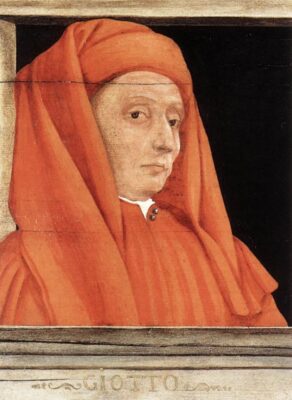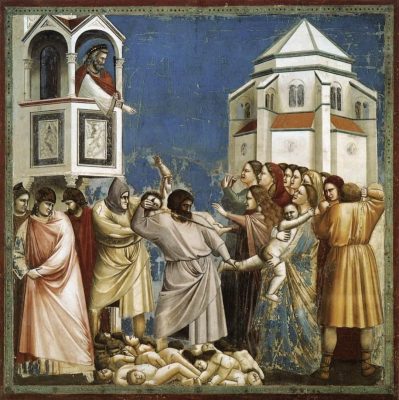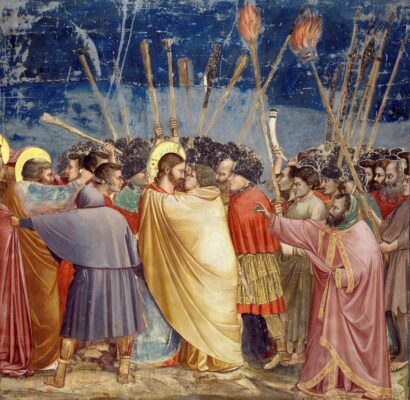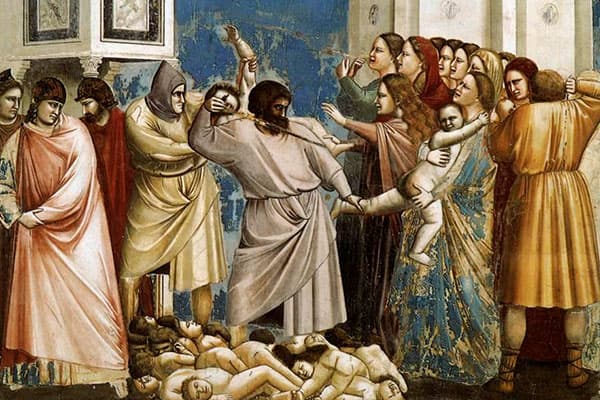Giotto di Bondone
“Credette Cimabue nella pittura / Tener lo campo, ed ora ha Giotto il grido/ sì, che la fama di colui oscura “
Dante, Divine Comedy
In his “Lives of the artists”, Giorgio Vasari mentioned the following story: in a quiet day, Florentine painter Cimabue (c.1240-1302) was walking through the countryside when he observed a young shepherd, just a little boy, painting ewes on a rock with a white chalk. When the master asked him about his name, the kid said: “My name is Giotto, and my father is called Bondone”
Image: Paolo Uccello: alleged portrait of Giotto di Bondone
This story is probably untrue, but it is useful as an introduction to the art of Giotto di Bondone (1266-1337), the painter who, with his unusually imaginative talent, his original iconographies, and his remarkable love for the nature and the human expression, revolutionized Western Art to the point that many critics consider him, not without reason, the first genius of European painting, praised by his contemporaries Dante, Petrarca and Boccaccio. Giotto “personifies the new Dantesque taste, with all that this word means in terms of interest in human feelings” (History of Art, Salvat Editores, Volume 5, 1981). At his death in 1337, at age 70, Giotto left a school with important disciples (Bernardo Daddi, Taddeo Gaddi…) who directed Florentine painting until the arrival of the great quattrocentist masters like Fra Angelico.
The first works of Giotto, still very close to Cimabue’s stylistic features, already began to show some of his original pictorial characteristics: that is the case of the Crucifix in the Church of Santa Maria Novella, in Florence (painted between 1290-1295), where the humanization of the figure of Christ is completely different than the those found on the hieratic Byzantine crucifixes.
Giotto di Bondone: frescoes in the Scrovegni Chapel: “The Massacre of the Innocents” and “The Kiss of Judas”. 1304-05
The first masterpiece by Giotto are the frescoes that he painted at the Basilica of San Francisco in Assisi, between 1296 and 1300, based on the legend of Saint Bonaventure. Nevertheless, these works do not reach the perfection of those in the Scrovegni Chapel, in Padua, where, in addition to the individual quality of each scene (from the dramatism of “The Massacre of the Innocents” to the mysterious faces of the women in the “Meeting of Saint Joachim and Saint Anna”), the value of the spatial conception of the entire set is added. Giotto painted another series of frescoes for the Church of Santa Croce, already in his maturity (c. 1325).
In addition to these frescoes, Giotto made several paintings on panels, being the most famous the “Madonna in Majesty” (known as the “Ognissanti Madonna“) in which the face of the Virgin, far from the cold and hieratic inexpressiveness of the Byzantines panels, shows an expressivity that suggests the possibility of having been taken from a living human model, perhaps a Florentine young woman. It is also known that Giotto was an accomplished architect, receiving the assignment of designing the campanile in the Cathedral of Florence, although he probably only made a few sketches.
Giotto was to Western Painting a phenomenon that all his contemporaries tried to follow, but none of them were able to reach until the appearance of Fra Angelico and the primitive flamenco masters of the early 15th Century.
G. Fernández · theartwolf.com
Related content
Follow us on:




